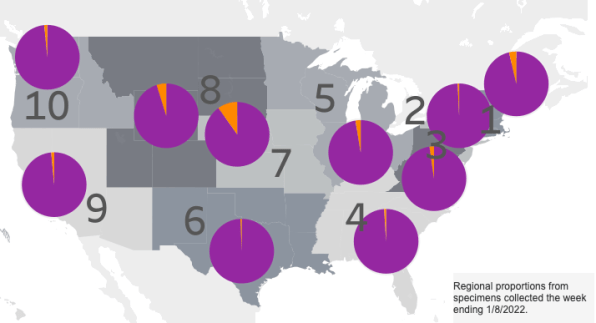Omicron variant in the U.S.: Updated CDC tracker now shows near complete takeover
Omicron has become the Google Search of American COVID-19 variants in a matter of five short weeks. It now dominates an estimated 98.3% of cases nationwide, according to the latest modeled data from the Centers for Disease Control and Prevention (CDC). For the most recent week for which it has figures—January 2 to 8—the CDC says omicron seized an even greater share of total infections in the United States. For the prior week, its estimated proportion was 92.3%, revised down from 95.4% when the data first became available.
Since landing in California back on December 1, the variant has spread with alarming alacrity. It accounted for only 58.6% of cases as recently as the week of Christmas. Since the new year began, it’s been the dominant strain in all 10 U.S. regions that the CDC model tracks. The latest numbers shifted it upward again. Omicron now accounts for 99% or more of cases in three U.S. regions: Region 2 (New Jersey, New York, and U.S. Caribbean territories), Region 4 (Alabama, Florida, Georgia, Kentucky, Mississippi, North Carolina, South Carolina, and Tennessee), and Region 6 (Arkansas, Louisiana, New Mexico, Oklahoma, Texas, and tribal territories).
Delta, meanwhile, has practically fallen off the chart, comparatively speaking, making up just 1.7% of the cases modeled by the CDC’s Nowcast tool.

Updated every Tuesday, Nowcast provides a snapshot of how COVID variants of concern are spreading in something closely approximating real time, so public-health officials can take faster action. It bases the variants’ prevalence on genomic-sequencing data. One hangup of such a hurried turnaround, though, is that it means the dataset isn’t always complete, which can affect its accuracy. In past weeks, it’s been revised substantially as the CDC gathers additional samples nationwide.
Regardless of omicron’s exact share of the total right now, more health experts have started warning this may be just the start of its global takeover. The World Health Organization (WHO) estimated today that in the coming two months, the variant could infect most of Europe. Observing current transmission trends, WHO Europe director Hans Kluge said, “At this rate, more than 50% of the population in the region will be infected with omicron in the next six to eight weeks,” a scale, he noted, that would be “unprecedented.”
(38)

